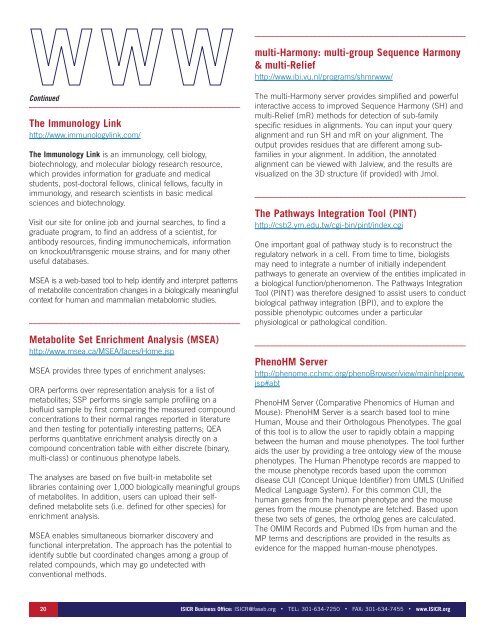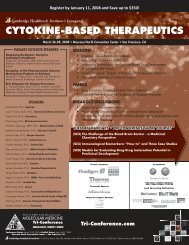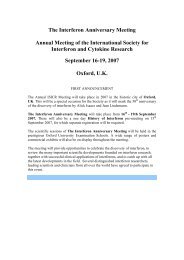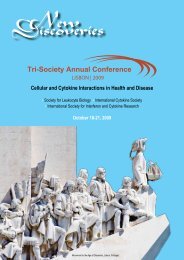9th Joint Meeting ISICR-ICS Cytokines & Interferons: From the ...
9th Joint Meeting ISICR-ICS Cytokines & Interferons: From the ...
9th Joint Meeting ISICR-ICS Cytokines & Interferons: From the ...
You also want an ePaper? Increase the reach of your titles
YUMPU automatically turns print PDFs into web optimized ePapers that Google loves.
WWW<br />
Continued<br />
The Immunology Link<br />
http://www.immunologylink.com/<br />
The Immunology Link is an immunology, cell biology,<br />
biotechnology, and molecular biology research resource,<br />
which provides information for graduate and medical<br />
students, post-doctoral fellows, clinical fellows, faculty in<br />
immunology, and research scientists in basic medical<br />
sciences and biotechnology.<br />
Visit our site for online job and journal searches, to find a<br />
graduate program, to find an address of a scientist, for<br />
antibody resources, finding immunochemicals, information<br />
on knockout/transgenic mouse strains, and for many o<strong>the</strong>r<br />
useful databases.<br />
MSEA is a web-based tool to help identify and interpret patterns<br />
of metabolite concentration changes in a biologically meaningful<br />
context for human and mammalian metabolomic studies.<br />
Metabolite Set Enrichment Analysis (MSEA)<br />
http://www.msea.ca/MSEA/faces/Home.jsp<br />
MSEA provides three types of enrichment analyses:<br />
ORA performs over representation analysis for a list of<br />
metabolites; SSP performs single sample profiling on a<br />
biofluid sample by first comparing <strong>the</strong> measured compound<br />
concentrations to <strong>the</strong>ir normal ranges reported in literature<br />
and <strong>the</strong>n testing for potentially interesting patterns; QEA<br />
performs quantitative enrichment analysis directly on a<br />
compound concentration table with ei<strong>the</strong>r discrete (binary,<br />
multi-class) or continuous phenotype labels.<br />
The analyses are based on five built-in metabolite set<br />
libraries containing over 1,000 biologically meaningful groups<br />
of metabolites. In addition, users can upload <strong>the</strong>ir selfdefined<br />
metabolite sets (i.e. defined for o<strong>the</strong>r species) for<br />
enrichment analysis.<br />
MSEA enables simultaneous biomarker discovery and<br />
functional interpretation. The approach has <strong>the</strong> potential to<br />
identify subtle but coordinated changes among a group of<br />
related compounds, which may go undetected with<br />
conventional methods.<br />
multi-Harmony: multi-group Sequence Harmony<br />
& multi-Relief<br />
http://www.ibi.vu.nl/programs/shmrwww/<br />
The multi-Harmony server provides simplified and powerful<br />
interactive access to improved Sequence Harmony (SH) and<br />
multi-Relief (mR) methods for detection of sub-family<br />
specific residues in alignments. You can input your query<br />
alignment and run SH and mR on your alignment. The<br />
output provides residues that are different among subfamilies<br />
in your alignment. In addition, <strong>the</strong> annotated<br />
alignment can be viewed with Jalview, and <strong>the</strong> results are<br />
visualized on <strong>the</strong> 3D structure (if provided) with Jmol.<br />
The Pathways Integration Tool (PINT)<br />
http://csb2.ym.edu.tw/cgi-bin/pint/index.cgi<br />
One important goal of pathway study is to reconstruct <strong>the</strong><br />
regulatory network in a cell. <strong>From</strong> time to time, biologists<br />
may need to integrate a number of initially independent<br />
pathways to generate an overview of <strong>the</strong> entities implicated in<br />
a biological function/phenomenon. The Pathways Integration<br />
Tool (PINT) was <strong>the</strong>refore designed to assist users to conduct<br />
biological pathway integration (BPI), and to explore <strong>the</strong><br />
possible phenotypic outcomes under a particular<br />
physiological or pathological condition.<br />
PhenoHM Server<br />
http://phenome.cchmc.org/phenoBrowser/view/mainhelpnew.<br />
jsp#abt<br />
PhenoHM Server (Comparative Phenomics of Human and<br />
Mouse): PhenoHM Server is a search based tool to mine<br />
Human, Mouse and <strong>the</strong>ir Orthologous Phenotypes. The goal<br />
of this tool is to allow <strong>the</strong> user to rapidly obtain a mapping<br />
between <strong>the</strong> human and mouse phenotypes. The tool fur<strong>the</strong>r<br />
aids <strong>the</strong> user by providing a tree ontology view of <strong>the</strong> mouse<br />
phenotypes. The Human Phenotype records are mapped to<br />
<strong>the</strong> mouse phenotype records based upon <strong>the</strong> common<br />
disease CUI (Concept Unique Identifier) from UMLS (Unified<br />
Medical Language System). For this common CUI, <strong>the</strong><br />
human genes from <strong>the</strong> human phenotype and <strong>the</strong> mouse<br />
genes from <strong>the</strong> mouse phenotype are fetched. Based upon<br />
<strong>the</strong>se two sets of genes, <strong>the</strong> ortholog genes are calculated.<br />
The OMIM Records and Pubmed IDs from human and <strong>the</strong><br />
MP terms and descriptions are provided in <strong>the</strong> results as<br />
evidence for <strong>the</strong> mapped human-mouse phenotypes.<br />
20 <strong>ISICR</strong> Business Office: <strong>ISICR</strong>@faseb.org • TEL: 301-634-7250 • FAX: 301-634-7455 • www.<strong>ISICR</strong>.org







